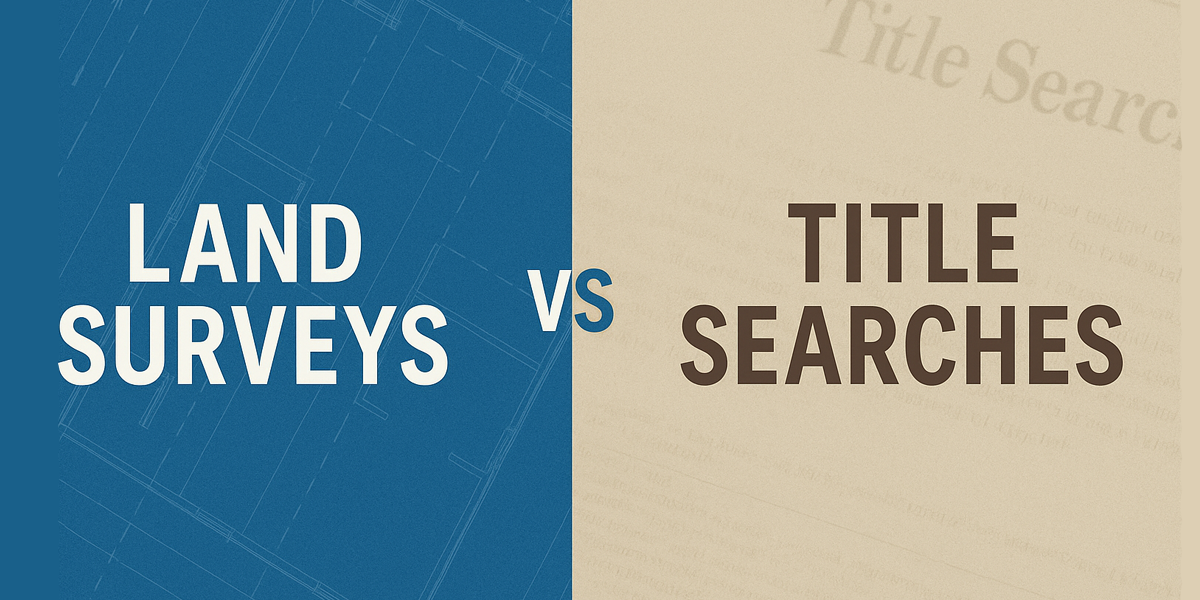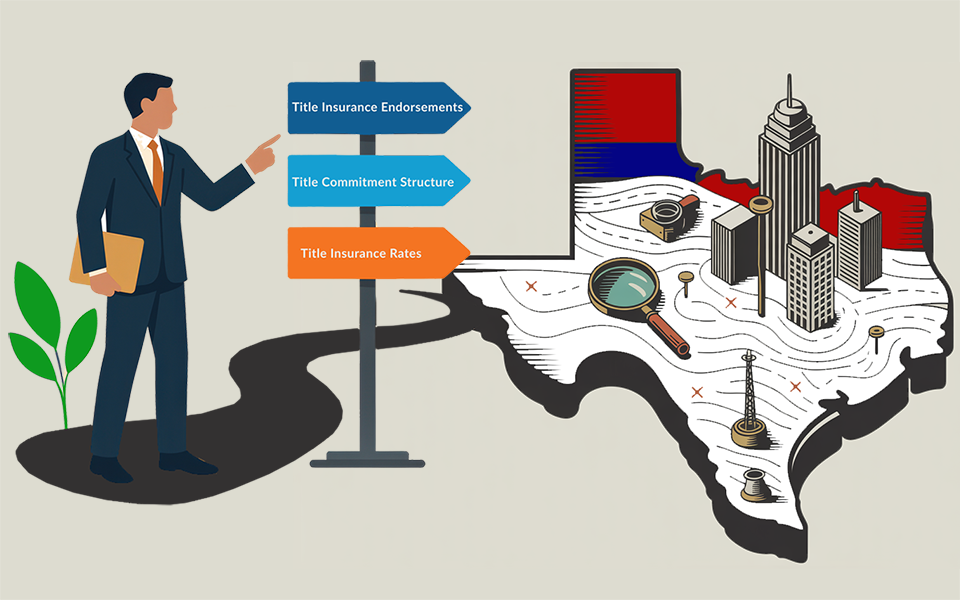December 22, 2025
The Importance of Land Surveys in Property Transactions: What You Need to Know

In property transactions, boundary or land surveys play a crucial role in ensuring a smooth and successful transfer of ownership. Whether you're a prospective buyer or seller, a real estate agent, or a real estate attorney, understanding the importance of land surveys is essential. In this article, we will delve into the intricate details of land surveys in property transactions, providing you with the information you need to navigate land surveys in the real estate process. From explaining the purpose and significance of boundary/land surveys to outlining the steps involved, we will equip you with the knowledge to navigate property transactions and make informed decisions confidently. Join us as we explore the world of land surveys and unlock a deeper understanding of this vital component in the realm of real estate.
The Role of Land Surveys in Property Transactions
Understanding Land Surveys
Land/Boundary surveys are specialized procedures conducted to determine the exact boundaries of a piece of property. These surveys are necessary to establish the extent of the land to which a property owner has legal rights. A precise land survey can reveal the actual size and limits of the property, identify any encroachments by neighboring properties, and be an essential component in resolving property disputes.
Licensed surveyors conduct these surveys, and they involve the analysis of historical records and legal documents—such as deeds and land records—and the physical measurement of the land itself. The resulting documentation from a land survey visually represents the property vital for property development, construction, and ensuring compliance with zoning and building regulations. Recognizing the boundaries of a property helps all parties involved avoid potential legal issues and enables a clear understanding of property ownership.
Why are Land Surveys crucial?
Land surveys are crucial for several reasons. First, they prevent disputes with neighbors by clearly defining where one property ends and another begins. This clarity can save property owners from costly and time-consuming legal battles. Additionally, these surveys are often required by law before the sale or development of land, ensuring that all transactions are based on accurate property information.
Moreover, land surveys protect buyers' investment by revealing any issues that may need to be addressed before a purchase is finalized, such as encroachments or easements that could affect the value or use of the property. For sellers, providing a current land survey can enhance the marketability of their property by offering potential buyers confidence in what they are purchasing. In essence, land surveys are vital for ensuring transparency and safeguarding the rights and obligations of all parties involved in property transactions.
The Legal Aspects of Land Surveys
Land surveys are deeply intertwined with legal aspects of property ownership and transfer. They often form the basis for resolving legal disputes regarding land boundaries and are used in court as evidence. The survey creates a permanent record that defines the property lines and is sometimes required by local or state regulations before any building permits are issued or before the land is subdivided.
The surveyor's findings must adhere to the standards set by the state where the property is located, and a licensed professional must conduct the survey. The accuracy of these surveys is paramount as they can impact titles, deeds, and other legal documents. When changes are made to the property, such as dividing the land or adding new structures, an updated survey may be necessary to ensure ongoing legal compliance. Property owners should be aware that ignoring the legal necessity for a land survey may result in problematic legal implications down the road.
The Process of Conducting a Land Survey
The Initial Phase: Research
The initial phase of a land survey is comprehensive research, such as the research conducted by Skyline Title Support. This step is critical as it lays the groundwork for the surveying process. Surveyors must gather and review all relevant documents, including the property deed, prior surveys, and any existing property descriptions. They also examine historical maps and records to understand past boundaries and any changes that have occurred over time.
This research phase may also involve reviewing municipal and county records to check for registered easements, rights of way, or other encumbrances that could affect the property. Understanding the historical context of the property's boundaries is essential to provide an accurate and legally sound survey. The information collected during this phase helps the surveyor prepare for the physical surveying of the property and anticipate any potential issues that may arise during the fieldwork stage.
Fieldwork: Walking the Property
Once the initial research is complete, the next step involves fieldwork, where surveyors physically walk the property. In this hands-on phase, surveyors use their expertise and specialized equipment, such as GPS devices, measuring tapes, and stakes, to gather accurate data about the property's terrain and boundaries.
During this process, surveyors may place markers at the corners of the property to identify the extent of the land. They look for existing monuments or markers from previous surveys and compare them with the legal descriptions in the research phase. Fieldwork is a meticulous process that may involve navigating through difficult terrain and ensuring every measurement is precise.
If there are discrepancies between the historical records and the current state of the property, the surveyor will note these differences for further investigation. The physical survey confirms written records and uncovers any issues that may have yet to be previously documented.
Analysis and Preparation of the Survey
Following the fieldwork, surveyors proceed with analyzing the data collected. This involves carefully examining the measurements and notes taken during the property walk. Surveyors use this data to create a detailed map of the property, which accurately represents the land's boundaries and other significant features.
This map, or plat, is then cross-referenced with the research conducted in the initial phase to ensure consistency and accuracy. Surveyors prepare a written report accompanying the map, providing a narrative explaining the survey's findings and any potential legal implications.
The final survey report and plat are then provided to the property owner. These documents are often used in real estate transactions, legal cases, or land development planning. They are crucial tools for decision-making processes involving the property, as they translate complex legal descriptions and technical data into a precise, visual representation of the property.
Key Features to Identify in a Land Survey
Monuments and Landmarks
Identifying monuments and landmarks is a critical aspect of boundary surveys. In surveying, monuments refer to physical objects placed at property corners or along boundary lines, such as iron rods, concrete pillars, or natural features like trees or stones, historically recognized as markers of boundary lines.
Surveyors seek these out as they represent the physical evidence of the property's historical boundaries. These markers are essential in verifying and establishing the property lines and are often referenced in legal property descriptions. On the other hand, landmarks can include prominent features like buildings, roads, or rivers that describe the location or extend the property boundaries.
Accurately identifying and documenting these physical markers is necessary to maintain the integrity of the property's legal boundaries and prevent future disputes. These features link the property's historical boundary data and are integral to the boundary survey report.
Property Lines and Easements
A key feature of land surveys is identifying property lines—imaginary lines that define the legal boundaries of a parcel of land. Establishing the precise location of these lines is essential for determining the true extent of an owner's property. Surveyors use a combination of physical markers and legal descriptions to delineate these lines accurately.
Easements are another critical feature that boundary surveys must identify. An easement is a legal right to use another person's land for a specific purpose, such as a driveway or utility line. Surveyors need to locate any existing easements tied to the property because they can affect the owner's rights and may impact future development plans. Maps of easements are crucial to ensure all parties know these rights and prevent legal issues related to property use. Documenting property lines and easements is vital for subsequent land transactions or development projects.
Discrepancies in Property Size
During a land survey, it is crucial to identify discrepancies in property size. These discrepancies can occur when the physical measurements of the property do not match the size noted in legal documents or previous surveys. This might happen due to incorrect or outdated records, unrecorded property changes, or neighboring property encroachments.
Such discrepancies can significantly affect the value and usability of land. For instance, a property believed to be larger than it is may sell for more than its actual value, or a smaller property may limit the owner's ability to build or expand as planned. Accurately identifying and documenting the property's actual size helps ensure that all parties involved make decisions based on correct information.
Resolving these discrepancies often requires legal actions such as updating property deeds or negotiating with neighbors. Therefore, detecting and addressing any issues with property size early on is essential to prevent potential disputes or financial losses.
Risks Involved in Skipped Land Surveys
Potential Legal Disputes
Skipping a survey can lead to potential legal disputes, which can be some of the most significant risks in property transactions. With a current survey, property boundaries may be clear, but they may be assumed based on outdated or incorrect information, leading to conflicts with neighbors over where one property ends and another begins.
Legal disputes can arise from unintentional encroachments, where a property owner builds a structure that inadvertently crosses into a neighboring property. Resolving ownership and boundary issues can result in costly and stressful litigation. Moreover, disputes may also concern the right of access, especially if easements need to be correctly identified.
These legal battles can be protracted and expensive, often requiring the services of attorneys and commissioning a new land survey as part of the dispute resolution process. The potential for legal disputes underscores the importance of conducting an accurate land survey before any property changes hands or undergoes significant changes.
Unexpected Land Encroachments
One of the risks associated with skipping a land survey is the possibility of unexpected land encroachments. Encroachments occur when a property owner violates the property boundaries by building a structure or installing a fence on land that does not belong to them. Without a proper survey, these can go unnoticed for years and can become significant issues when the property is sold or developed.
Encroachments can lead to alterations to the encroaching structures or even legal action to resolve the infringement on another's property. They can also affect a property's marketability, as potential buyers may be deterred by the complications and additional costs that may arise from resolving these issues.
Performing a land survey can identify these encroachments early on, allowing them to be addressed before they become larger and more complex problems. It helps ensure that property lines are respected and maintained, protecting the property owner's rights and investments.
The Risk of Financial Loss
Failure to conduct a boundary survey can lead to significant financial loss. Property owners might face unexpected costs to correct boundary-related issues, such as removing or altering structures encroaching on a neighbor's land. Additionally, a property's value could be diminished if a survey uncovers less usable land than previously thought, directly impacting the owner's equity.
In the case of a property sale, the discovery of boundary issues can disrupt or even nullify the transaction, leading to lost time and money for both the buyer and seller. Moreover, unresolved boundary disputes can result in legal costs and the possibility of having to pay damages or restitution to affected parties.
For developers, the financial risks are even more significant, as construction projects may need to be halted or redesigned to accommodate actual property boundaries. The cost of rectifying these issues post-construction can be prohibitive, which means it is of the utmost importance to invest in a boundary survey and make a prudent decision upfront.
Hiring a Professional vs DIY Land Survey
The Expertise of a Licensed Surveyor
Hiring a licensed surveyor brings a level of expertise and precision that is critical for a reliable land survey. Surveyors are trained professionals who deeply understand land measurement techniques, legal issues, and local regulations. They can interpret complex legal descriptions and have access to specialized equipment necessary for accurate measurements.
A professional surveyor conducts thorough research and analysis, drawing upon years of experience to identify potential issues that may only be evident to someone with their training. They are also familiar with the latest surveying technology and methods, which contribute to the accuracy and reliability of their work.
Moreover, the involvement of a licensed surveyor adds legal weight to the survey, which can be essential in the case of disputes or if the survey needs to be presented in a legal setting. A licensed surveyor's expert knowledge and skills can save property owners from future complications, making their services a valuable investment.
The Limitations of a DIY Survey
Attempting a DIY boundary survey comes with several limitations. Achieving the precision required for a legal boundary survey is only possible with professional training. Individuals may need more technical skills and access to the professional-grade equipment crucial for accurate measurements, such as theodolites, GPS devices, and total stations.
Additionally, interpreting legal property descriptions and understanding how to apply them on the ground is complex and can easily lead to errors. A mistake in a DIY survey can result in land disputes or legal issues, which could ultimately incur more costs than hiring a professional in the first place.
Another significant limitation is the lack of legal standing for a DIY survey. A self-conducted survey is unlikely to be recognized by courts or local authorities, which means it offers little to no protection or benefit in legal situations. For these reasons, a DIY boundary survey is generally not advisable for those seeking accurate and legally defensible property boundaries.
Costs Involved: Hiring Professionals vs DIY
When considering the costs of hiring a professional surveyor versus conducting a DIY survey, it's essential to look beyond the initial expenditure. Professional surveyors charge for their expertise, time, and use of specialized equipment, a significant upfront cost compared to a low-cost DIY approach.
However, the potential long-term costs of an inaccurate DIY survey can far outweigh the initial savings. Mistakes can lead to boundary disputes, legal fees, and the potential of re-surveying by professionals later on. Furthermore, the peace of mind that comes with a professional survey and its legal standing is invaluable.
On the other hand, the DIY approach might save some money initially, but it needs more precision, legal recognition, and professional assurance. When factoring in potential risks and future complications, the investment in a professional boundary survey is often the most cost-effective and secure choice for property owners.
Related Posts
2026 Title Industry Outlook: Top 10 Trends That Will Redefine Due Diligence and Closings
The title industry is heading into 2026 with more moving parts than at any time in recent memory: rapid regulatory change, deeper fraud risk ...
December 22, 2025
Witchy Titles & Cursed Closings: What Salem’s History Can Teach Us About Real Estate Due Diligence
In 1692, the town of Salem, Massachusetts descended into chaos. Fueled by fear, rumors, and suspicion, dozens of people were accused of witchcraft and ...
December 22, 2025
Title Under Siege: A First Look at Our New Guide to Deed Fraud and Seller Impersonation
Seller impersonation, in particular, is on the rise. In these cases, a scammer poses as the property owner—usually targeting vacant land, rental...
December 22, 2025
Real Estate Due Diligence Checklist: 9 Hidden Costs That Kill Closings
Imagine this: A $3.2 million Miami Beach home sale implodes because of a $127 unpaid utility lien that no one caught in time. Absurd as it sounds ...
December 22, 2025
Land Surveys vs. Title Searches: When You Need Both (and How to Budget)
Picture this: you’re days away from closing on a home when an unexpected hiccup surfaces. The seller’s old fence sits two feet inside the neighbor’s...
December 22, 2025
How Can Large Title Companies Thrive in Volatile Times?
When mortgage rates climbed to 23-year highs in late 2023, one national title insurer watched transaction volume plummet 45% over eight weeks yet ...
December 22, 2025
Summer Real Estate: Keep Closings Cool When the Market Heats Up
Summer signals one of the busiest times in real estate, especially in Florida, as well as in fast-growing markets like Texas, Arizona, and ...
December 22, 2025
Navigating Florida’s Title Regulations for Small Title Agencies
Running a small to mid-sized title agency in Florida can feel like juggling flaming torches—there’s licensing, escrow accounting, audits, data security ...
December 22, 2025
Top Mistakes When Ordering a UCC Search
UCC Searches are crucial in risk assessment and due diligence in commercial lending and secured transactions. Yet despite their importance, we have ...
December 22, 2025
The Title Pro's AI Companion: Using Skyline's SmartTitle Assistant
How much time did you spend drafting repetitive client emails today? Our average title professional saves 5+ hours weekly using SmartTitle Assistant™ ...
December 22, 2025
Navigating Market Volatility: What Title Professionals Need to Know Now — and What's Ahead in 2025
In today's real estate landscape, the only constant is change. Fluctuating interest rates, economic uncertainty, and shifting regulatory policies have ...
December 22, 2025
What Happens if a Satisfaction of Mortgage is Not Properly Recorded?
Paying off a mortgage is a significant financial milestone, but the process isn’t complete until the lender records the mortgage satisfaction with the ...
December 22, 2025
Generating New Business for Title Companies in a Competitive Market
The title industry is transforming. Increased competition, technological advancements, and shifting consumer expectations are challenging traditional ...
December 22, 2025
Spring Cleaning for Your Property Title: How to Refresh Your Real Estate Records
Millions of real estate transactions are delayed or fall apart each year due to title issues that could have been prevented. In fact, a recent study ...
December 22, 2025
Top Strategies to Prevent Quiet Title Issues
Quiet title disputes are a serious concern for real estate professionals, as they can disrupt transactions and create uncertainty around property ownership ...
December 22, 2025
Title Services for New Construction: What Builders and Developers Need to Know
The construction of a new home or commercial property is an exciting and ambitious project, but it comes with more than just design and building ...
December 22, 2025
Will AI Agents Replace Title Professionals? The Truth About Automation
Artificial intelligence (AI) has evolved beyond simple data analytics and chatbots. Today's AI "agents" can interact with web browsers, gather and analyze ...
December 22, 2025
10 Reasons Why Skipping a Land Survey Can Be Costly
A land survey might seem like an unnecessary expense, especially if the property has been owned for years without any issues. However, skipping this step ...
December 22, 2025
Title Industry 2.0: Harnessing AI, Data, and Cybersecurity for a Resilient Future
The title industry is at a crossroads. Traditional methods that have served us well for decades now face mounting challenges in an increasingly ...
December 22, 2025
How Title Services Impact Mortgage Underwriting Timelines
In the world of real estate, the journey from application to closing is filled with numerous moving parts. Among these, title services are a crucial yet ...
December 22, 2025
How Title Companies Can Meet Tight Deadlines Without Sacrificing Quality
In today's fast-paced real estate environment, speed is crucial. Title companies often find themselves in high-pressure situations where they must juggle ...
December 22, 2025
5 New Year's Resolutions for Title Companies in 2025
As 2025 kicks off, the title industry is moving faster than ever. With new technologies, shifting customer needs, and more complex regulations, there’s ...
December 22, 2025
How to Explain Title Insurance to Your Clients: A Real Estate Agent's Guide
Explaining title insurance isn't always straightforward, but with the right approach, it can become a valuable teaching moment for your clients. Picture this ..
December 22, 2025
The Hidden Complexities of Property Title Searches
You've found your dream home. The price is right, the location is perfect, and you're ready to sign on the dotted line. But before you do ...
December 22, 2025
What’s Next for the Title Industry? Key Trends for 2025
The title industry is at a pivotal moment, with 2025 shaping up to be a year of significant transformation. From groundbreaking technologies like blockchain ...
December 22, 2025
Commercial Property Title Due Diligence: Going Beyond the Basics
The landscape of commercial property title due diligence has transformed dramatically over the past three decades. Gone are the days when a basic title ...
December 22, 2025
Navigating the Cyber Minefield: A Title Professional's Complete Guide to Phishing Defense
The title industry is a prime target for cybercriminals, and phishing is one of the most common threats that title professionals face today. Imagine this ...
December 22, 2025
Elevating Your Title Company to New Heights - A Blueprint for Growth
Let's be honest – growing a title company isn't what it used to be. Gone are the days when simply maintaining the status quo was enough to ...
December 22, 2025
This Halloween Avoid Real Estate Nightmares: 5 Spooky Title Issues That Can Haunt You
Buying a new home is exciting, but not all surprises are welcome. Some title issues can be like ghostly figures lurking in the shadows ...
December 22, 2025
Understanding Municipal Lien Searches: A Complete Guide
Imagine this scenario: You've discovered an incredible property, yet as the closing date approaches, an unsettling surprise reveals itself—a municipal lien...
December 22, 2025
Wire Fraud : Proven Defense Tactics for Title Professionals
Wire fraud is a rapidly growing threat in the real estate industry, with fraudsters becoming more sophisticated and aggressive in their ...
December 22, 2025
Preparing for August 17th: Essential Information on the NAR Broker Commission Changes
The real estate market is about to undergo significant changes as new commission regulations take effect on August 17. These changes ...
December 22, 2025
Maximize Efficiency in Your Title Business with AI
Integrating AI into title businesses can significantly enhance efficiency, accuracy, and customer service. By automating routine tasks, improving...
December 22, 2025
Summer Selling Season: Essential Steps for Real Estate Pros to Ensure Smooth Transactions
Essential steps for real estate professionals to ensure smooth transactions during the bustling summer selling season include preparing properties, ...
December 22, 2025
10 Interesting Facts About Colonial Land Ownership
Colonial America’s land ownership shaped the U.S. under British rule. Exploring these practices reveals the era’s struggles and innovations in property rights.
December 22, 2025
Recent Posts
















































